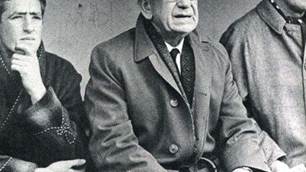When the rules of touch were drawn up, a new generation of participants got to play the "greatest game of all".
 A game of touch can break out anywhere. Photo: Getty Images.
A game of touch can break out anywhere. Photo: Getty Images.It’s amazing how many sporting teams – including Aussie rules teams – play a game called “touch football” as a way of keeping sharp without risking injury. Yet many, especially outside of the rugby league states, give little thought to the fact that it is the offspring of rugby league.
The game was only invented in 1963, yet not very long afterward it had caught on to such an extent that it was played at playtime and lunchtime, before and after school, at just about every school in those states – and why not? Touch footy, or “tip”, as we often called it, could be organised in seconds, didn’t require a football (in fact the object could be anything at all), needed no goal posts and team numbers varied, depending on who was available. It was fun, it was hectic, and it was a great way to burn off the excess energy many of us still wish we had. The game actually had us running and dodging for hours every day.
It has since become an organised sport in its own right and is played around the world.
The founders of touch football were Bob Dyke and Ray Vawdon, of the influential South Sydney Junior Rugby League Club, who invented it as a method of training for the rugby league team, and as a means of allowing retired players to keep running around in a competitive game. By 1968, it had become a stand-alone sport when the South Sydney Touch Football Club was formed. Dyke and Vawdon organised the first official game, and both remained involved in its codification and administration right up until Dyke’s death in 2010. During that time, they watched as its popularity spread beyond their wildest imaginings.
Touch is based on its parent game, but teams are split into three main positions: two wings, two “middles” and two “links” (between the wings and middles, one on each side of the field). This fluid, ever-moving game has proved perfect for training at the elite level. But it’s also friendly to people of any standard or fitness level, and even features mixed-gender games.
Games are played on a paddock half the size of a standard field (70 x 50 metres). There are variations like beach touch, one-touch (in which the attacking team is allowed one possession before handing the ball over), two-touch (the same, but with two touches). Each team can consist of up to 14 players, of which six players can be on the field at any one time.
To make the game even more fluid and continuous, substitutions are unlimited, can be made at any time and never interrupt the flow of play. The standard duration for a game is 40 minutes with a five-minute half-time. Each “touchdown” is worth one point, as there are no goals to vary the scoring. In official games, the ball is slightly smaller than a rugby league ball – often the “rugby size four” ball. The clothing is typically light. Players normally wear soft, rubber-cleated shoes.
Once Dyke and Vawdon codified their game, it spread quickly interstate. By 1973, representative matches were held, and in 1975 it spread to New Zealand.
By 1976, the game had grown enough to justify the establishment of the Australian Touch Football Association. In 1977, after the drawn grand final between St George and Parramatta, the replay required a curtain-raiser. Touch football was perfect. The touch association was contacted, and in front of a record SCG crowd, the spectacular prelude was a showcase for the sport. Controversy is always good publicity, and in 1978, the game briefly grabbed headlines when Sydney Metropolitan defeated a touring Great Britain side with a disputed try on full-time.
As is the case with many easily played and organised games, touch has broad appeal. In recent years, it has begun to be played widely in Asia, the South Pacific, Europe and the United Kingdom. The World Cup, established in 1988 and played once every four years, now attracts more than 50 nations. World Cups have been played in Australia, New Zealand, Japan, South Africa and Scotland. In 2015 it will be held in Australia.
There are regular Tests between Australia and New Zealand known as Trans-Tasman Tests, and the Federation of International Touch (FIT) oversees the European Touch Championships, or “Euros”, every two years. The biennial World All Schools attracts the participation of hundreds of schools from all around the world.
Before Bob Dyke died (Vawdon continues as an active administrator), he lived to see a great idea become a reality which was embraced internationally – an idea that seemed so obvious, if it didn’t exist, it would have been necessary to invent it. In other words, the very best of ideas. Who could hope for more?
Related Articles

Before Barassi, there was Frank "Checker" Hughes

Will our Olympians bounce back at this year's Games?













